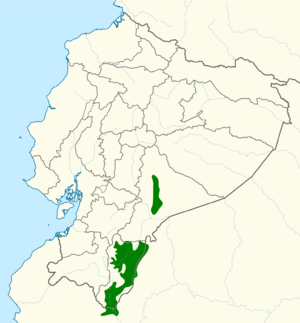White-breasted parakeet facts for kids
Quick facts for kids White-breasted Parakeet |
|
|---|---|
| Conservation status | |
| Scientific classification | |
| Genus: |
Pyrrhura
|
| Species: |
albipectus
|
 |
|
The white-breasted parakeet (Pyrrhura albipectus), also known as the white-necked parakeet, is a special type of parrot. It belongs to the parrot family, Psittacidae, which includes African and New World parrots. This bird is listed as a Vulnerable species, meaning its population is at risk. You can find it mainly in southern Ecuador and possibly in nearby northern Peru.
Contents
About the White-breasted Parakeet
What Makes This Parakeet Unique?
The white-breasted parakeet is a unique bird. It is the only species of its kind in the Pyrrhura group that does not have different subspecies. This means all white-breasted parakeets are very similar to each other.
How to Spot a White-breasted Parakeet
This parakeet is about 24 to 25.5 cm (9.4 to 10.0 in) long. It weighs between 83 to 110 g (2.9 to 3.9 oz). Both male and female parakeets look the same.
Adult birds have a thin reddish-brown band just above their beak. Their head, from forehead to the back, is brownish with gray-edged feathers. Their cheeks are green with yellow, making them look a bit scaly. The feathers covering their ears are orange.
A wide white collar goes around their neck. The rest of their upper body is green. Their chest is yellow, and the rest of their belly is green with a rusty color. Their wings are mostly green. They have red primary coverts and dark bluish primary feathers. The top of their tail is dull reddish with a green base. The underside is dusky with reddish tips. They have a blackish beak and dark eyes. White or whitish skin surrounds their eyes.
Young parakeets look like adults but do not have the reddish band on their forehead. Their ear feathers are also lighter, and their chest is white.
Where White-breasted Parakeets Live
Parakeet Homes in the Andes
The white-breasted parakeet lives on the eastern slopes of the Andes mountains. You can find them in the southeastern Ecuadorian provinces of Morona-Santiago and Zamora-Chinchipe. There might also be some in the northern part of Cajamarca in Peru.
Some experts believe they are only found in Ecuador. However, there have been unconfirmed sightings in Peru. These birds prefer to live in the tops of trees, clearings, and edges of untouched subtropical and tropical forests. They usually live at elevations between 900 and 2000 m (2,950 and 6,560 ft) high. Most often, they are found below 1700 m (5,580 ft).
Parakeet Behavior and Life
Daily Movements of Parakeets
Scientists do not know much about how white-breasted parakeets move around. They do not seem to have any regular migration patterns.
What Do Parakeets Eat?
White-breasted parakeets enjoy a varied diet. They eat fruits, seeds, and flowers from many different plants and trees.
Parakeet Reproduction and Nests
White-breasted parakeets build their nests between May and July. However, not much else is known about how they raise their young.
How Parakeets Communicate
The most common sound a white-breasted parakeet makes is a series of harsh notes. It sounds like "krree krree krree." They make this sound both when sitting on a branch and when flying.
When perched, they might also make single "kurree" or "rrah" notes. But often, perched birds are quiet. When many parakeets fly together, they call frequently and at the same time. This creates a loud, harsh chattering sound.
Protecting the White-breasted Parakeet
Why This Parakeet is Vulnerable
The IUCN (International Union for Conservation of Nature) first listed the white-breasted parakeet as Threatened. Since 1994, it has been listed as Vulnerable. This means its population is small, with fewer than 10,000 adult birds. This number is believed to be shrinking.
The biggest problem for these birds is habitat destruction. Forests in the upper tropical zone east of the Andes are being cut down very quickly. This removes the homes these parakeets need to survive.
Conservation Efforts for Parakeets
The white-breasted parakeet lives in protected areas like Podocarpus National Park and the Tapichalaca Reserve. However, Podocarpus National Park has lost some habitat due to illegal activities. In the Tapichalaca Reserve, a group called Fundación Jocotoco has put up special nest boxes for the parakeets. These boxes help provide safe places for the birds to lay their eggs and raise their young.


